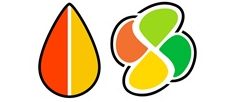Stickers on Japanese cars.
 2021.04.02
2021.04.02Regardless of driving in Japan or not, you might notice some stickers on Japanese cars.
These are some of them:

Source: illustAC
These stickers are required to be placed on the cars for specific reasons.
Beginner mark(初心者標識)

After obtaining a driving license, drivers are required by law to put this sticker on the front and the back of the car for one year. This mark also to be called “WAKABA marks”(若葉マーク) perhaps because it looks like a newly grown leaf, just as fresh as the new driver. Some interesting things are this beginner mark sometimes to be used for many other occasions, even a new horse-rider. You can find its Emoji🔰 available for many smartphones and other digital products. It’s easy and clear to pass the message: I am inexperienced beginner, please understand that!
Elderly person mark (高齢者標識)

Anyone is over 70 years old is required to place this mark on the car when driving. The one on the left side is an older version, and the one on the right is the current one. You might see both of them on Japanese cars with same indication: the driver is an elderly person. The old design, to be called “autumn leaf” when compare to Beginner’s fresh leaf, somehow had rather offensive image to elderly. In 2011, a new design of a brighter colorful clover replaced the former.
Hearing-impaired person mark(聴覚障害者)

This mark is for drivers with hearing difficulties. Hearing-impaired drivers must place it on their cars as it is mandatory. The word “hear” sounds similar with “butterfly” in Japanese, which makes it easy to remember. Also, the wings represent two ears make the mark visually impressive.
Handicapped person mark (身体障害者標識)

It is a four-leaf umbrella symbol. Although it is a best-effort requirement but not mandatory, it is preferable that handicapped drivers use it on their cars to gain more attention and understanding from other drivers.
Many shopping centers have put these marks on the ground of parking lot, usually near the entrance, to provide better convenience to people in need.
When a driver sees surrounding cars have these marks on it, he or she should avoid cutting in front it, or go extremely close to the car, forcing it drive to the side of the road. These behaviors are legally forbidden under Japanese Road Traffic Act.





